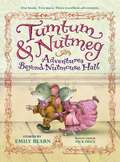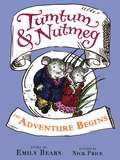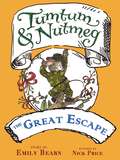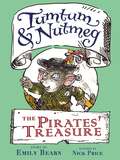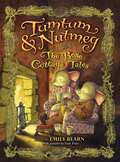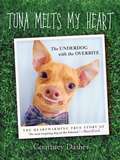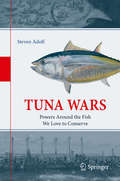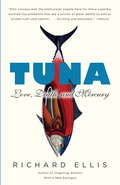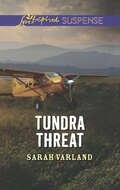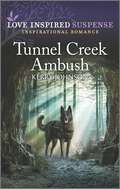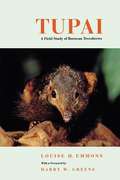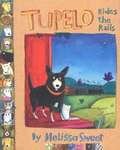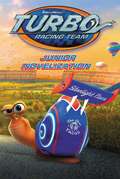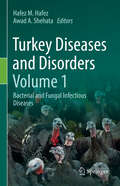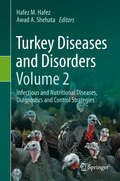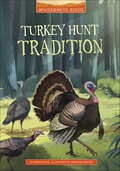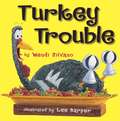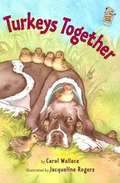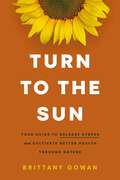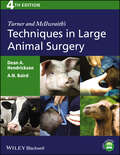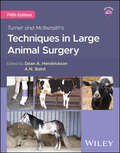- Table View
- List View
Tumtum & Nutmeg: Adventures Beyond Nutmouse Hall (Tumtum & Nutmeg #1)
by Emily Bearn Nick PriceDeep inside the broom cupboard of Rose Cottage, two mice live in great style. Tumtum and Nutmeg lead cozy and quiet lives, secretly looking after Arthur and Lucy, the disheveled human children of the cottage, never dreaming that so many exciting adventures will soon find them. But when evil Aunt Ivy, a squeamish schoolteacher named Miss Short, and pirating pond rats threaten the safety of those they hold dear, the courageous pair will stop at nothing to save the day. In three thrilling tales with charming illustrations in every chapter, Tumtum and Nutmeg--along with the valiant efforts of veteran hero General Marchmouse, Ms. Tiptoe's bouncing ballerina army, and a team of caged gerbils--prove that small-size mice can have world-size hearts.
Tumtum & Nutmeg: The Adventure Begins (Tumtum & Nutmeg #1)
by Emily Bearn Nick PriceTumtum & Nutmeg: The Adventure Begins is the first of three short stories from Tumtum & Nutmeg: Adventures Beyond Nutmouse Hall. Tumtum and Nutmeg lead cozy and quiet lives, secretly looking after Arthur and Lucy, the disheveled human children of Rose Cottage, never dreaming that so many exciting adventures will soon find them. But when evil Aunt Ivy, a squeamish schoolteacher named Miss Short, and pirating pond rats threaten the safety of those they hold dear, the courageous pair will stop at nothing to save the day. In this thrilling tale of daring and wit, Tumtum and Nutmeg -- along with veteran hero General Marchmouse, Ms. Tiptoe's bouncing ballerina army, and a team of caged gerbils -- prove that small mice can have big hearts.
Tumtum & Nutmeg: The Great Escape (Tumtum & Nutmeg #1)
by Emily Bearn Nick PriceTumtum & Nutmeg: The Great Escape is the second of three short stories from Tumtum & Nutmeg: Adventures Beyond Nutmouse Hall. Tumtum and Nutmeg lead cozy and quiet lives, secretly looking after Arthur and Lucy, the disheveled human children of Rose Cottage, never dreaming that so many exciting adventures will soon find them. But when evil Aunt Ivy, a squeamish schoolteacher named Miss Short, and pirating pond rats threaten the safety of those they hold dear, the courageous pair will stop at nothing to save the day. In this thrilling tale of daring and wit, Tumtum and Nutmeg -- along with veteran hero General Marchmouse, Ms. Tiptoe's bouncing ballerina army, and a team of caged gerbils -- prove that small mice can have big hearts.
Tumtum & Nutmeg: The Pirates' Treasure (Tumtum & Nutmeg #1)
by Emily Bearn Nick PriceTumtum & Nutmeg: The Pirates' Treasure is the third of three short stories from Tumtum & Nutmeg: Adventures Beyond Nutmouse Hall. Tumtum and Nutmeg lead cozy and quiet lives, secretly looking after Arthur and Lucy, the disheveled human children of Rose Cottage, never dreaming that so many exciting adventures will soon find them. But when evil Aunt Ivy, a squeamish schoolteacher named Miss Short, and pirating pond rats threaten the safety of those they hold dear, the courageous pair will stop at nothing to save the day. In this thrilling tale of daring and wit, Tumtum and Nutmeg -- along with veteran hero General Marchmouse, Ms. Tiptoe's bouncing ballerina army, and a team of caged gerbils -- prove that small mice can have big hearts.
Tumtum & Nutmeg: The Rose Cottage Tales (Tumtum & Nutmeg #2)
by Emily BearnDeep inside the broom cupboard of Rose Cottage, two mice live in great style. Tumtum and Nutmeg lead cozy and quiet lives, secretly looking after Arthur and Lucy, the disheveled human children of the cottage, never dreaming that so many exciting adventures will soon find them. But when evil Aunt Ivy, a squeamish schoolteacher named Miss Short, and pirating pond rats threaten the safety of those they hold dear, the courageous pair will stop at nothing to save the day.
Tuna Melts My Heart: The Underdog with the Overbite
by Courtney DasherTuna’s cartoonish looks—with an exaggerated overbite, a recessed jawline, and a wrinkly neck—are truly one of a kind. And yet his quirky appearance is no match for his unique perspective on life, overcoming his proclivity for staying in bed all day to keep his eye on the (bacon-flavored) prize. <P><P> Teaming up with his owner, Courtney Dasher, Tuna shares a behind-the-scenes look at his daily exploits, which include sleeping, sunbathing, wearing bow ties, playing with toys, and melting hearts. <P> Packed with witty and endearing images of this ridiculously adorable pup, Tuna Melts My Heart is sure to delight the underdogs in us all!
Tuna Wars: Powers Around the Fish We Love to Conserve
by Steven AdolfHistorically, whenever tuna was hauled ashore, the sounds of battle were never far away. ‘Tuna Wars’ tells the untold story of the power struggles emerging around tuna, from the distant past to your present-day dinner table.In the ancient past, the giant tuna was the first fish to become the basis of a large-scale industry and a ‘global’ trade that created fortunes: Hannibal was able to finance his elephant campaign on Rome thanks to tuna. From the Middle Ages on, a tuna fishing monopoly on Spain’s southern coast allowed the nobility to completely dominate the area and even lead the ‘invincible’ Armada. When the markets for tuna increased exponentially thanks to technical advances, tuna eventually became a billion-dollar business and one of the most-consumed fish species worldwide.But this massive expansion came at a price. An 18th century monk in Madrid was the first to warn that tuna fisheries needed to be run sustainably for the sake of future generations. And the issue of sustainability would go on to become a game-changer in the modern tuna wars, characterized by new alliances and partnerships, hybrid warfare and commercial power struggles. In addition to accompanying you through the history of tuna and sharing insights into fisheries science and approaches to sustainably managing fisheries, Tuna Wars offers practical guidance on choosing sustainably fished tuna. In short, it will tell you everything you ever wanted to know about tuna, but were afraid to ask.
Tuna: A Love Story
by Richard EllisThe author ofThe Book of Sharks,Imagining Atlantis, andEncyclopedia of the Seaturns his gaze to the tuna—one of the biggest, fastest, and most highly evolved marine animals and the source of some of the world’s most popular delicacies—now hovering on the brink of extinction. In recent years, the tuna’s place on our palates has come under scrutiny, as we grow increasingly aware of our own health and the health of our planet. Here, Ellis explains how a fish that was once able to thrive has become a commodity, in a book that shows how the natural world and the global economy converge on our plates. The longest migrator of any fish species, an Atlantic northern bluefin can travel from New England to the Mediterranean, then turn around and swim back; in the Pacific, the northern bluefin can make a round-trip journey from California to Japan. The fish can weigh in at 1,500 pounds and, in an instant, pick up speed to fifty-five miles per hour. But today the fish is the target of the insatiable sushi market, particularly in Japan, where an individual piece can go for seventy-five dollars. Ellis introduces us to the high-stakes world of “tuna ranches,” where large schools of half-grown tuna are caught in floating corrals and held in pens before being fattened, killed, gutted, frozen, and shipped to the Asian market. Once on the brink of bankruptcy, the world’s tuna ranches—in Australia, Spain, France, Italy, Greece, Turkey, and North Africa—have become multimillion-dollar enterprises. Experts warn that the fish are dying out and environmentalists lobby for stricter controls, while entire coastal ecosystems are under threat. The extinction of the tuna would mean not only the end of several species but dangerous consequences for the earth as a whole. In the tradition of Mark Kurlansky’sCod, John Cole’sStriper, John Hersey’sBlues—and of course, Ellis’s ownGreat White Shark—this book will forever change the way we think about fish and fishing.
Tunas (Nature's Children)
by Brian WardDescribes the physical features, habits and habitat of tuna, a valuable food fish.
Tundra Threat
by Sarah VarlandAn Alaska wildlife trooper tries to track down a killer on her own—while the pilot who broke her heart tries desperately to protect her . . .Two murdered men are the last thing wildlife trooper McKenna Clark expected to find in the stark Alaskan wilderness. As the only law enforcement in the area, the responsibility for the case rests on her shoulders—along with the danger.Hunting guide and pilot Will Harrison wants to ease the load, but McKenna balks at the thought of letting him close enough to break her heart again. When McKenna’s investigations put her in harm’s way, Will must race against the clock to save his second chance at love from becoming the killer’s final victim . . .
Tunnel Creek Ambush
by Kerry JohnsonDanger lurks in the shadows… and a police dog is keeping watch Officer Jasper Holt never thought he&’d see his high school girlfriend, Kinsley Miller, again—much less become her protector. But when the wildlife biologist returns home for her aunt&’s funeral, she&’s attacked twice in a matter of hours. With his K-9 partner at his side, the single father will protect Kinsley with his life. But can they uncover the reason behind the assaults…before the next strike becomes the last?From Love Inspired Suspense: Courage. Danger. Faith.
Tupai: A Field Study of Bornean Tree Shrews
by Louise EmmonsAn exemplary account of field work on a very interesting animal by one of the foremost tropical mammologists.
Tupelo Rides the Rails
by Melissa SweetAward-winning author/illustrator Melissa Sweet introduces Tupelo, an abandoned dog, who must find a new home for herself and her sock toy, Mr. Bones. With creative language and brilliant illustrations, Melissa shows how home is sometimes found in the most unexpected places.
Turbo Junior Novelization
by Tracey WestRelive the fast-paced thrills of Turbo in this retelling of the new DreamWorks Animation movie. Comes with eight pages of images from the movie! The DreamWorks movie Turbo revs up in theaters on July 19, 2013! Turbo is a snail who dreams of being the greatest racer in the world, just like his hero, five-time Indianapolis 500 champ, Guy Gagné. Turbo's obsession with speed and all things fast has made him an outsider in the slow snail community, and a constant embarrassment to his cautious older brother, Chet. Turbo desperately wishes he could escape the slow-paced life he's living--and he gets his chance after a freak accident bestows him with the power of incredible speed. Turbo embarks on an extraordinary journey to achieve the impossible: racing against the best that IndyCar has to offer. Does he have what it takes to cross the finish line first? Find out in this retelling of the DreamWorks movie, Turbo! DreamWorks Turbo © 2013 DreamWorks Animation L.L.C.
Turfgrass Insects of the United States and Canada
by Patricia J. VittumThe first edition of this reference work became known as the bible of turfgrass entomology upon publication in 1987. It has proved invaluable to professional entomologists, commercial turf managers, and golf course superintendents and has been used widely in college extension courses. This classic of the field is now in its third edition, providing up-to-date and complete coverage of turfgrass pests in the continental United States, Hawaii, and southern Canada.This revised volume integrates all relevant research from the previous two decades. It provides expanded coverage of several pest species, including the annual bluegrass weevil, invasive crane fly species, chinch bugs, billbugs, mole crickets, and white grubs. Patricia J. Vittum also provides detailed information on the biology and ecology of all major pests and includes the most current information on conditions that favor insect development and biological control strategies pertinent to each species.This edition will include more than 100 black-and-white images, including diagrams of life cycles, sketches of morphological characteristics, and charts highlighting seasonal activity. The book also includes 72 full-color plates (more than 500 color images), showing closeup pictures of most of the key insects (adult and immature stages) and damaged turf. The reader should be able to identify most turf insects through the use of this text. It is a critical reference work that any serious turf professional should own.
Turkey Diseases and Disorders Volume 1: Bacterial and Fungal Infectious Diseases
by Hafez M. Hafez Awad A. ShehataThis volume 1 of a two-volume work provides an overview of the current state of knowledge on the most common bacterial and fungal diseases in turkeys. Each chapter is dedicated to a specific infectious disease and provides information on pathogenesis, symptoms and therapeutic strategies. The book also includes a general overview on turkey production. The clear and structured layout allows the reader to refer to it quickly. This book is an indispensable guide for veterinarians, researchers and professionals working in turkey production and health.
Turkey Diseases and Disorders Volume 2: Infectious and Nutritional Diseases, Diagnostics and Control Strategies
by Hafez M. Hafez Awad A. ShehataThis volume 2 of a two-volume work provides an overview of the current state of knowledge on the most common viral and parasitic diseases in turkeys. Each chapter is dedicated to a specific infectious disease and provides information on pathogenesis, symptoms and therapeutic strategies. The book also addresses nutritional diseases in fattening turkeys, and introduces diagnostic techniques as well as disease prevention and control strategies. The clear and structured layout allows the reader to refer to it quickly. This book is an indispensable guide for veterinarians, researchers and professionals working in turkey production and health.
Turkey Goes to School (Fountas & Pinnell Classroom, Guided Reading Kindergarten)
by Linda Silvestri Kate DopirakNIMAC-sourced textbook
Turkey Hunt Tradition (Wilderness Ridge)
by Monica RoeTwelve-year-old April Clark is passionate about two things: woodworking and hunting, both skills learned from her beloved grandfather. But this year, GrandJack is recovering from a health problem and can’t join the trip to turkey camp. He tells her that a different sort of trip can still be great and gives her his prize box call to bring for luck. On the day of the hunt, April is determined to land the biggest, best tom she can. But her insistence on only getting the best turkey leads her to make a big mistake. Suddenly, the huge gobbler she’s bagged doesn’t seem quite so perfect. To make things right with GrandJack—and herself—April will have to figure out if different can still be good, and whether perfect really is best.
Turkey Trouble
by Wendi SilvanoAs Thanksgiving Day approaches, Turkey nervously makes a series of costumes, disguising himself as other farm animals in hopes that he can avoid being served as Thanksgiving dinner.
Turkeys (Nature's Children)
by Ben HoareWhat do you call a baby turkey? How big are turkeys? Where do wild turkeys live? What's an ocellated turkey? Find the answers to these questions, and learn much more about the physical characteristics, behavior, habitat, and lives of turkeys.
Turkeys Together
by Carol WallaceA pointer dog puppy helps a mother turkey figure out how to protect her eggs from being stolen.
Turn to the Sun: Your Guide to Release Stress and Cultivate Better Health Through Nature
by Brittany GowanTurn to the Sun guides you down a nourishing path of uplifting affirmations, soul-refreshing meditations, and lush botanical photography that helps you heal in the company of nature. Approach your days with less anxiety, renewed vigor, and a deeper sense of well-being as you become grounded and soak up nature's restorative qualities.Whether you live in an urban jungle, on a suburban cul-de-sac, or at the edge of a national forest, you might find yourself more connected to technology than to nature. In the midst of the pings and rings of a device-dependent life, is getting close to nature even possible—or worth it?Wellness coach and the founder of Pause with Plants Brittany Gowan shows you how slowing down, unplugging, and connecting with the natural world is not only possible and absolutely worth it, but also essential. Brittany creates a reflective experience enhanced by plants that helps you find the calm and tranquility you crave.In these gorgeous, photo-filled pages, you'll find ways to:Cultivate mindfulness as you let go of daily distractionsLet nature guide you into relishing the present momentUse a nature-focused mindset to persist through challengesConnect and ground yourself with nature anywhere, anytimeNourish your relationship with yourself and the world around you Turn to the Sun includes:Affirmations: simple statements that have a positive effect on your thoughts and actionsMeditations: guidance for reflection and contemplation to center your mind and bodyHow-tos: doable exercises to fully engage with the natural worldStunning botanical photography: lush images of plants that pair with affirmations, meditations, and how-tos When in your life have you felt most alive? You can feel that way again. You can flourish, with purpose, whether you are in a waiting season or ready to blossom. It's time to pause. It's time to breathe. It's time to grow.
Turner and McIlwraith's Techniques in Large Animal Surgery
by Dean A. Hendrickson A. N. BairdTurner and McIlwraith's Techniques in Large Animal Surgery, Fourth Edition is an updated version of the classic resource for step-by-step instruction on basic surgical techniques in cattle, horses, swine, goats, and llamas. With detailed line drawings to demonstrate the principles discussed, the book addresses general aspects of surgery such as anesthesia and equipment and provides descriptions of surgical conditions and techniques commonly encountered in large animal practice. Now including a website with interactive review questions and the figures from the book in PowerPoint, the Fourth Edition is a highly practical, reliable guide for veterinary students and veterinary practitioners with a large animal caseload.The Fourth Edition includes eight new techniques and completely rewritten chapters on anesthesia, equine wound management, and surgical techniques in bovine and swine patients, as well as revisions to reflect advances throughout the book and updated references. Turner and McIlwraith's Techniques in Large Animal Surgery continues to supply students and practitioners alike with a valuable resource on the fundamental techniques of farm animal surgery.
Turner and McIlwraith's Techniques in Large Animal Surgery
by A. N. BairdAn indispensable resource for students and practitioners in large animal surgery, updated with new practices and techniques Turner and McIlwraith’s Techniques in Large Animal Surgery provides the critical knowledge needed to confidently approach even the most challenging surgical cases. Authored by highly experienced practitioners, this comprehensive resource offers step-by-step guidance on both routine procedures and complex surgical interventions for cattle, horses, swine, goats, llamas, and camelids. Concise chapters are organized in an efficient table-based format, allowing for rapid reference in both exam preparation and real-world clinical scenarios. The fifth edition of this classic textbook continues to set the standard for clear and reliable guidance on large animal surgery, equipping readers with the most current knowledge in clinical veterinary practice. Carefully reviewed references and enhanced visuals are accompanied by critical updates on equine orthopedic surgery, veterinary anesthesia, dental surgery, upper respiratory surgery, and more. Addressing everything from basic pre-surgical care to specialized reconstructive procedures, Turner and McIlwraith’s Techniques in Large Animal Surgery: Describes the surgical conditions and techniques commonly encountered in large animal practiceCovers general aspects of surgery including preoperative evaluation, suturing materials and patterns, and postoperative infectionContains a wealth of high-quality illustrations that clarify each step in complex surgical proceduresFeatures interactive multiple-choice questions for self-assessment and reinforcing key conceptsIncludes downloadable images in PowerPoint format, enabling instructors and practitioners to quickly create customized presentations Turner and McIlwraith’s Techniques in Large Animal Surgery, Fifth Edition is a must-have for veterinary students taking introductory surgery courses such as Principles of Surgery, Clinical Sciences, and Livestock Medicine, as well as for veterinary practitioners in equine and livestock surgery looking for an up-to-date reference.
